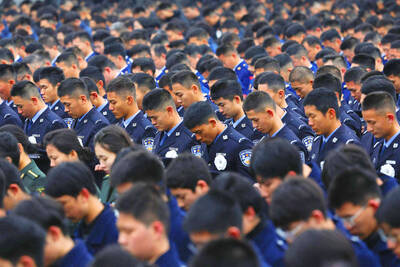Chinese Internet users reacted with outrage to reports of a racist assault on six Chinese oenology students studying in France yesterday, while others denounced the victims, who they said were children of wealthy officials.
The students were attacked in the early hours of Saturday in France’s wine-producing region of Bordeaux, the French Ministry of the Interior said, describing the violence as an act of xenophobia.
Two of the three alleged attackers have been detained and are now in police custody, while a female student was seriously hurt in the face by a glass bottle which was thrown at her.
The attack was widely criticized on China’s most popular social networking service, Sina Weibo.
“How dangerous is France. We need to be cautious about going there now, and avoid going as far as we can. We should go to better countries,” one user wrote.
“This is too far for the French people. My impression of France used to be quite good, but now its damaged,” another said.
One of the victims was the daughter of a retired senior government official, the head of the student’s school said.
Chinese media carried reports of the attacks yesterday, but did not mention the victim’s political connections.
The topic of politicians sending their children abroad to study provokes widespread resentment in China and is rarely discussed by the country’s tightly controlled press, which is rarely allowed to discuss the family life of senior officials.
Still, some Internet users speculated that the students were wealthy.
“Those who can afford to study abroad are either the children of government officials or rich families,” one user said.
“They’re not worthy of sympathy,” another user said.
Others reading English-language reports turned their anger on the students.
“Even foreigners can’t bear with the migration of corrupted officials and are punishing them abroad. This is karma,” another user said.
“That a random violent crime abroad has a government official’s children involved again proves their are no clean officials in China,” another wrote.

PARLIAMENT CHAOS: Police forcibly removed Brazilian Deputy Glauber Braga after he called the legislation part of a ‘coup offensive’ and occupied the speaker’s chair Brazil’s lower house of Congress early yesterday approved a bill that could slash former Brazilian president Jair Bolsonaro’s prison sentence for plotting a coup, after efforts by a lawmaker to disrupt the proceedings sparked chaos in parliament. Bolsonaro has been serving a 27-year term since last month after his conviction for a scheme to stop Brazilian President Luiz Inacio Lula da Silva from taking office after the 2022 election. Lawmakers had been discussing a bill that would significantly reduce sentences for several crimes, including attempting a coup d’etat — opening up the prospect that Bolsonaro, 70, could have his sentence cut to

China yesterday held a low-key memorial ceremony for the 1937 Nanjing Massacre, with Chinese President Xi Jinping (習近平) not attending, despite a diplomatic crisis between Beijing and Tokyo over Taiwan. Beijing has raged at Tokyo since Japanese Prime Minister Sanae Takaichi last month said that a hypothetical Chinese attack on Taiwan could trigger a military response from Japan. China and Japan have long sparred over their painful history. China consistently reminds its people of the 1937 Nanjing Massacre, in which it says Japanese troops killed 300,000 people in what was then its capital. A post-World War II Allied tribunal put the death toll

‘UNWAVERING ALLIANCE’: The US Department of State said that China’s actions during military drills with Russia were not conducive to regional peace and stability The US on Tuesday criticized China over alleged radar deployments against Japanese military aircraft during a training exercise last week, while Tokyo and Seoul yesterday scrambled jets after Chinese and Russian military aircraft conducted joint patrols near the two countries. The incidents came after Japanese Prime Minister Sanae Takaichi triggered a dispute with Beijing last month with her remarks on how Tokyo might react to a hypothetical Chinese attack on Taiwan. “China’s actions are not conducive to regional peace and stability,” a US Department of State spokesperson said late on Tuesday, referring to the radar incident. “The US-Japan alliance is stronger and more

FALLEN: The nine soldiers who were killed while carrying out combat and engineering tasks in Russia were given the title of Hero of the Democratic People’s Republic of Korea North Korean leader Kim Jong-un attended a welcoming ceremony for an army engineering unit that had returned home after carrying out duties in Russia, North Korean state media KCNA reported on Saturday. In a speech carried by KCNA, Kim praised officers and soldiers of the 528th Regiment of Engineers of the Korean People’s Army (KPA) for “heroic” conduct and “mass heroism” in fulfilling orders issued by the ruling Workers’ Party of Korea during a 120-day overseas deployment. Video footage released by North Korea showed uniformed soldiers disembarking from an aircraft, Kim hugging a soldier seated in a wheelchair, and soldiers and officials